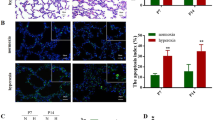Abstract
Objective
We investigated the effect of VIP on primary type II alveolar epithelial cells (AECIIs) upon the exposure of hyperoxia.
Methods
AECIIs were isolated and purified from premature rats and exposed to air (21% oxygen), hyperoxia(95% oxygen), VIP+air and VIP+hyperoxia, respectively. The proliferation and apoptosis of AECIIs were detected by MTT cell proliferation assay, flow cytometry and western blot. The production of intracellular reactive oxygen species (ROS) was determined by 2 ', 7'-dichloro-dihydrotestosterone fluorescein diacetate (DCFH-DA) molecular probe and the total antioxidant capacity (TAOC) by ultraviolate spectro-photometer.
Results
Cell proliferation significantly increased and apoptosis decreased upon the treatment with VIP. In addition, the level of ROS in the hyperoxia+VIP group was significantly lower than in the hyperoxia group, in contrast, TAOC was higher in the hyperoxia+VIP group than that in the hyperoxia group.
Conclusions
VIP exerts a protective role in the hyperoxia-induced oxidative stress damage in AECIIs, which probably attributed to its anti-oxidant and anti-apoptosis property.


Similar content being viewed by others
References
Altemeier WA, Sinclair SE. Hyperoxia in the intensive care unit: why more is not always better. Curr Opin Crit Care. 2007;13(1):73–8.
Pagano A, Barazzone-Argiroffo C. Alveolar cell death in hyperoxia-Induced lung injury. Ann NY Acad Sci. 2003;1010:405–16.
Miyake Y, Kaise H, Isono K, Koseki H, Kohno K, Tanaka M. Protective role of macrophages in noninflammatory lung injury caused by selective ablation of alveolar epithelial type II cells. J Immunol. 2007;178:5001–9.
Mantell LL, Lee PJ. Signal transduction pathway in hyperoxia-induced lung cell death. Mol Genet Metab. 2000;71:359–70.
Onoue S, Yamada S, Yajima T. Bioactive analogues and drug delivery systems of vasoactive intestinal peptide (VIP) for the treatment of asthma/COPD. Peptides. 2007;28:1640–50.
Vaudry D, Gonzalez BJ, Basille M, Yon L, Fournier A, Vaudry H. Pituitary adenylate cyclase activating polypeptide and its receptors: from structure to functions. Pharmacol Rev. 2000;52:269–324.
Howard DJ, Briggs LA, Pritsos CA. Oxidative DNA damage in mouse heart, liver, and lung tissue due to acute sidestream tobacco smoke exposure. Arch Biochem Biophys. 1998;352:293–7.
Dobbs LG, Gonzalez R, Williams MC. An improved method for isolating type II cells in high yield and purity. Am Rev Respir Dis. 1986;134(1):141–5.
Foschino Barbaro MP, Carpagnano GE, Spanevello A, Cagnazzo MG, Barnes PJ. Inflammation, oxidative stress and systemic effects in mild chronic obstructive pulmonary disease. Int J Immunopathol Pharmacol. 2007;20:753–63.
Jiang J, Xu F, Chen J. Repair, survival and apoptosis of type II alveolar epithelial cells and the change of bcl-2/p53 in oxidative stress. Zhonghua Er Ke Za Zhi. 2008;46:74–5.
Fattman CL. Apoptosis in pulmonary fibrosis: too much or not enough? Antioxid Redox Signal. 2008;10:379–85.
Said SI. Anti-inflammatory actions of VIP in the lungs and airways. In: Said SI, editor. Pro-Inflammatory and Anti-Inflammatory Peptides. (Vol. 112 in Lung Biology in Health and Disease. C Lenfant, Exec. Editor). New York: Marcel Dekker; 1998. p. 345–61.
Said SI. Protection by VIP and Related Peptides against Cell Death and Tissue Injury. Ann NY Acad Sci. 2000;921:264–74.
Leroux P, Vaudry H, Foumier A, et al. chamcterization and localization of vasoactive intestinal peptide receptors in the rat lung. Endocrinal. 1984;114(5):1506–12.
Foster N, Hulme SD, Barrow PA. Vasoactive intestinal peptide (VIP) prevents killing of virulent and phoP mutant Salmonella typhimurium by inhibiting IFN-gamma stimulated NADPH oxidative pathways in murine macrophages. Cytokine. 2006;36(3–4):134–40.
Said SI, Dickman K. Pathways of inflammation and cell death in the lung: modulation by vasoactive intestinal peptide. Regul Pept. 2000;93:21–9.
Onoue S, Ohmori Y, Endob K, Yamada S, Kimura R, Yajima T. Vasoactive intestinal peptide and pituitary adenylatecyclase activating polypeptide attenuate the cigarette smoke extract-induced apoptotic death of rat alveolar L2 cells. Eur J Biochem. 2004;271:1757–67.
Koh SW, Cheng J, Dodson RM, Ku CY, Abbondandolo CJ. VIP down-regulates the inflammatory potential and promotes survival of dying (neural crest-derived) corneal endothelial cells ex vivo: necrosis to apoptosis switch and up-regulation of Bcl-2 and N-cadherin. J Neurochem. 2009;109(3):792–806.
Acknowledgements
This study was supported by the National Natural Science Foundation of China (No. 30572365)
Author information
Authors and Affiliations
Corresponding author
Rights and permissions
About this article
Cite this article
Ao, X., Fang, F. & Xu, F. Role of Vasoactive Intestinal Peptide in Hyperoxia-Induced Injury of Primary Type II Alveolar Epithelial Cells. Indian J Pediatr 78, 535–539 (2011). https://doi.org/10.1007/s12098-010-0248-1
Received:
Accepted:
Published:
Issue Date:
DOI: https://doi.org/10.1007/s12098-010-0248-1




